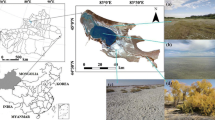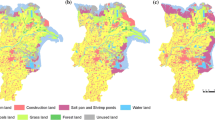Abstract
The upper valley of Min River (102°59′–104°14′E, 31°26′–33°16′N), which is consisted of the counties Wenchuan, Maoxian, Lixian, Heishui, and Songpan, refers to the part up to Dujiangyan City, and locates on the transition zone from the Tibetan Plateau to the Sichuan Basin. It is one of the most important forest areas in China, especially in Sichuan Province. Over past two decades, the landscape changed remarkably in the region. The 3S techniques (Remote Sensing (RS), Geographic Information System (GIS) and Global Position System (GPS)) were used to classify the images and analyze the landscape change. The remotely sensed data of Landsat TM 1986 and Landsat ETM+2000 were used to analyze the landscape change of the region. The landscape were classified into 10 types of cropland, forest, shrub land, economic forest, grassland, build up land, river, lake, swamp, and unused land. The results showed that: 1) the woodland and grassland were dominating landscape types in the upper valley of Min River, which is more than 91% of the study area; 2) the alteration of the landscape was mainly happened among forest, shrub land, grassland, economic forest, cropland, and build up land, where forest decreased from 51.17% to 47.56%; 3) the landscape fragmentation in the upper valley of Min River was aggravated from 1986 to 2000.
Similar content being viewed by others
References
Bureau of Agriculture and Pasturage, Office of Soil Survey, Sichuan Province. 1997. Soil of Sichuan [M]. Chengdu: Science and Technology Press of Sichuan. (in Chinese)
Chang, X.L., Wu, J.G. 1998. Spatial analysis of pattern of sandy landscapes in Kerqin, Inner Mongolia [J]. Acta Ecologica Sinica,18(3): 225–232. (in Chinese)
Editorial Board of Sichuan Vegetation. 1980. Sichuan Vegetation [M]. Chengdu: People's Publishing House of Sichuan. (in Chinese)
Forman, R. 1995. Land mosaics, the ecology of landscapes and regions [M]. Cambridge: Cambridge University Press, p 30–126.
Forman, R., Godron, M. 1986. Landscape ecology [M]. New York: Wiley & Sons, p 125–256.
Fu, B.J., Chen, L.D., Ma, K.M.,et al. 2001. Landscape ecology principal and application [M]. Beijing: Science Press, p 2–3. (in Chinese)
Gustafson, E.J. Parker, G.R. 1992. Relationship between land cover proportion and indices of landscape spatial pattern [J]. Landscape Ecology,7: 101–110
Hessburg, P., Smith, B., Salter, R.,et al. 2000. Recent changes (1930s–1990s) in spatial patterns of interior northwest forests, USA [J]. Forest Ecology and Management,136: 53–83.
Li, W.L. 1999. The ecological countermeasure to sustainable landscape development of Guangzhou [J]. Ecological Science,18(3): 60–65. (in Chinese)
Li, X.Z., Bu, R.C.et al. 2004. The response of landscape metrics against pattern scenarios [J]. Acta Ecologica Sinica,24(1): 123–134. (In Chinese)
Ma, K.M., Fu, B.J. 2000. Spatial neighboring and distribution regularities of landscape types in Donglingshan mountain region. Beijing, China [J]. Acta Ecologica Sinica,20(5): 748–752. (in Chinese)
Ma, K.M., Fu, B.J.,et al. 2004. Multiple-scale soil moisture distribution and its implications for ecosystem restoration in an arid river valley, China [J]. Land degradation and development,15: 75–85.
Turner, M.G., Lynn, R.C. 1988. Changes in landscape patterns in Georgia, USA [J]. Landscape Ecology,1(4): 241–251.
Wang, X.C., Sun, L.,et al. 2003. Dynamic of forest landscape in Heilongjiang Province for one century [J]. Journal of Forestry Research,14(1): 39–45.
Xiao, D.N. 1999. Discussion of the peoduction and development of contemporary landscape science [J]. Scientia Geographica Sinica,19(4): 379–384. (in Chinese)
Xu, J.H., Ai, N.S., Chen, Y.,et al. 2003. Quatitative analysis and fractal modeling on the mosaic structure of landscape in the central area of Shanghai metropolis [J]. Chinese Geographical Science,13(3): 199–206.
Yue, D.P., Wang, D.M., Zhao, T.N.,et al. 1997. Study on landscape pattern and ecology change in Beizang town, Daxing County, Beijing [J]. Journal of Beijing Forestry University,19(2): 35–41. (in Chinese)
Zang, S.Y., Zu, Y.G., Ni, H.W. 2000. Spatial pattern of forest resources sustainable exploitation [J]. Acta Ecologica Sinica,20(1): 73–79. (in Chinese)
Zhang, R.Z., Zheng, D., Yang, Q.Y. 1992. The Arid Valleys of the Hengduan Mountains Region [M]. Beijing: Science Press (in Chinese)
Zhang, X.C., Zeng, G.H., Zhang, Q.N. 2001. Geographic information system (GIS) in the city [M]. Beijing: Science Press. (in Chinese)
Author information
Authors and Affiliations
Corresponding author
Additional information
Foundation item: This project was supported by Major State Basic Research Development Program of China (973 Program) (No. 2002CB111506).
Biography: ZHAO Yong-hua (1975-), male, Ph.D. candidate, Instiute of Applied Ecology, the Chinese Academy of Sciences, Shenyang 110016, P.R. China.
Responsible editor: Song Funan
Rights and permissions
About this article
Cite this article
Yong-hua, Z., Xing-yuan, H., Yuan-man, H. et al. Landscape pattern change in the upper valley of Min River. Journal of Forestry Research 16, 31–34 (2005). https://doi.org/10.1007/BF02856850
Received:
Issue Date:
DOI: https://doi.org/10.1007/BF02856850




